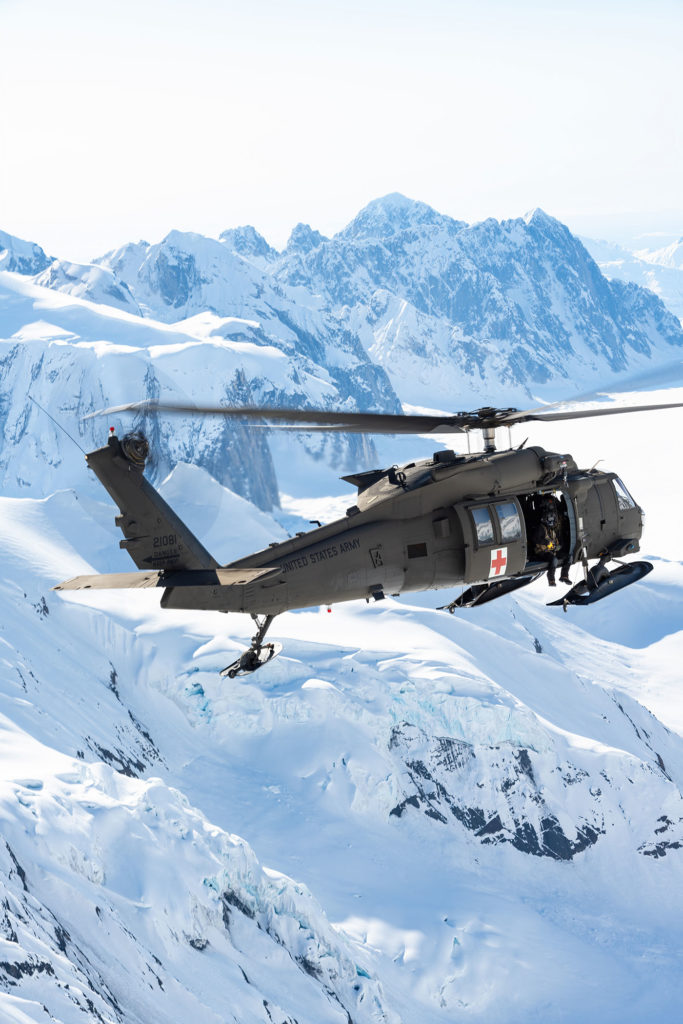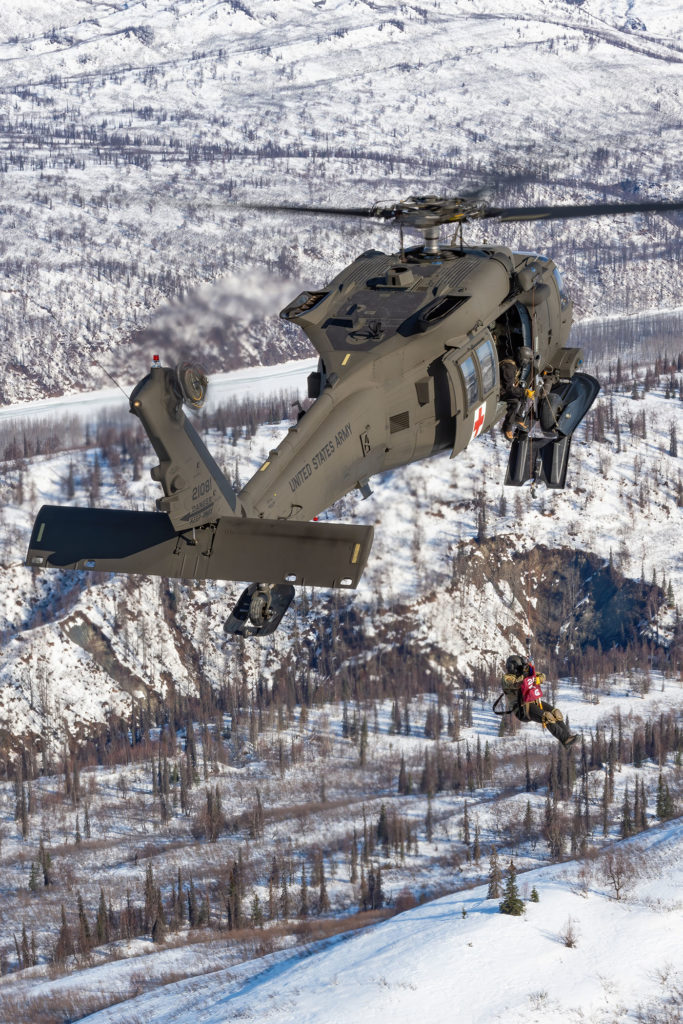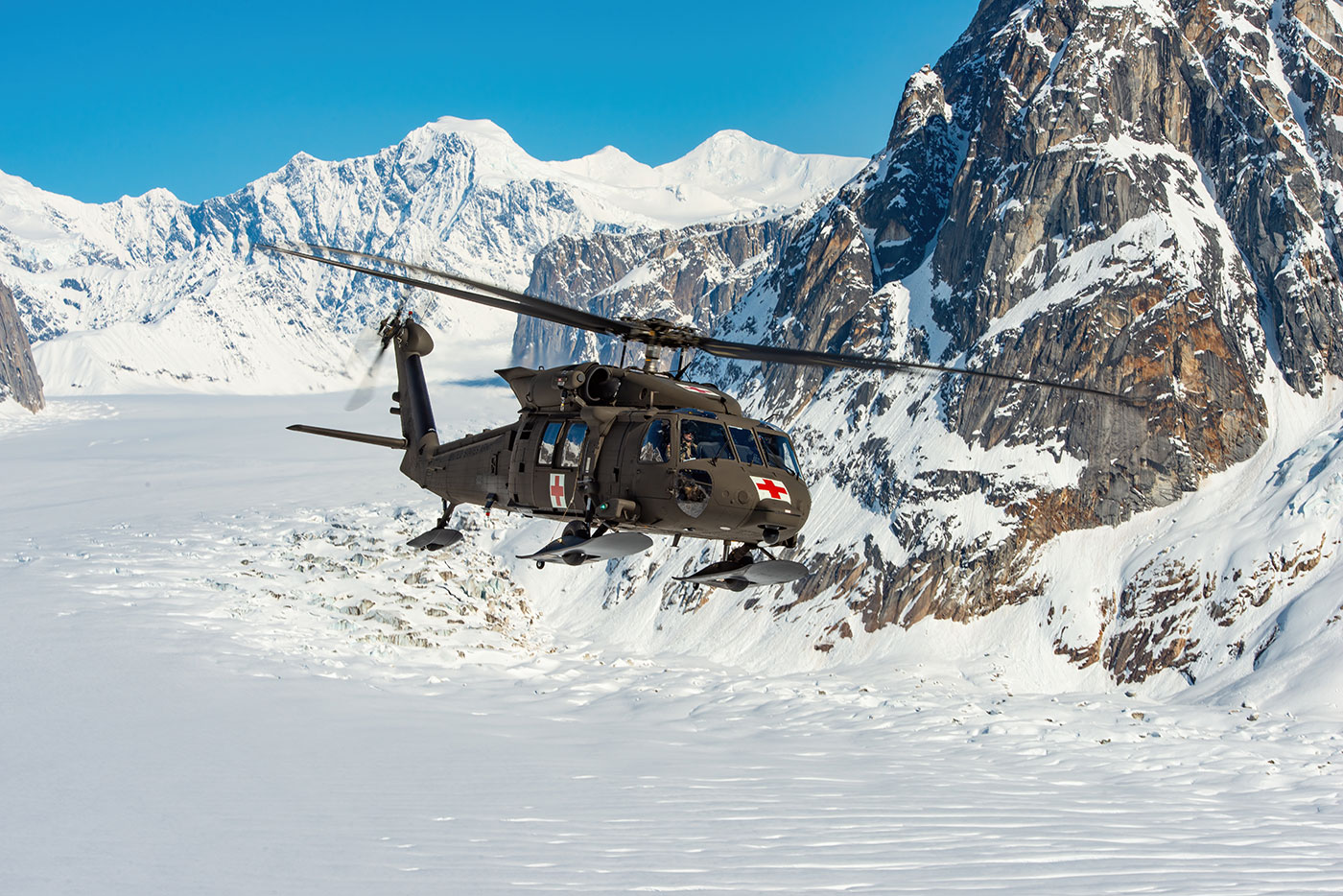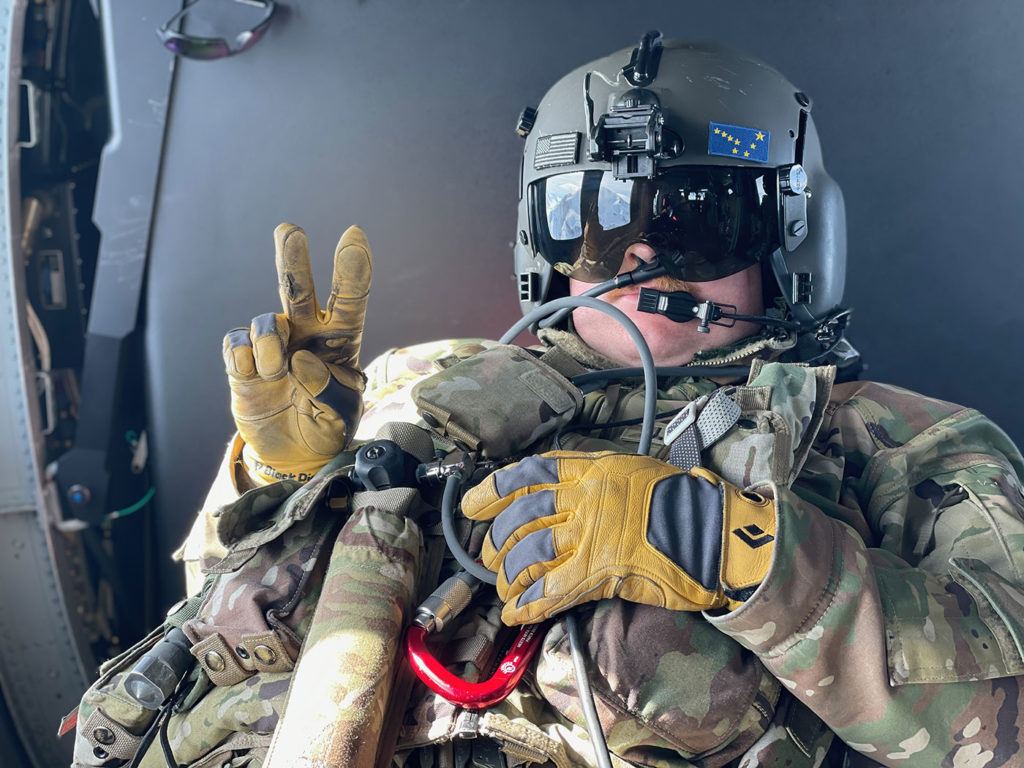In Alaska, a specially trained unit with the Army National Guard has taken on a relatively new domestic role. An element of the 1st Battalion, 207th Aviation Regiment recently stepped into a multi-mission role dedicated to search-and-rescue (SAR), air medical, hoist rescue and firefighting, for the citizens of the state.
This move comes as a result of the Army restructuring initiative (ARI), a program which began in 2014 aimed at upgrading capabilities, increasing efficiency and reducing costs across the Army’s active duty, Guard and Reserve aviation fleet.
Prior to ARI, the 207th was an air assault battalion operating mostly Sikorsky UH-60 Black Hawk helicopters. Their primary mission was support for ground troops in combat, troop and cargo movement and external load operations.

In the restructure, the National Guard and Army Reserves transferred most of their Boeing AH-64 Apache helicopters to active-duty units. In turn, the Guard and Reserves received additional Sikorsky UH-60 Black Hawks, as well as Boeing CH-47 Chinooks and Eurocopter (now Airbus) UH-72 Lakotas.
For the 207th, the fleet of utility and cargo airframes brought about a force structure change. This meant a move away from being strictly an air-assault battalion to a dual role as an air-assault and general-aviation battalion.
While the 207th still has elements tasked with troop support, the 207th Medevac Unit, Golf Company, now as a general aviation battalion, transitioned to a dedicated SAR/medevac unit.
“The Alaska Guard team has performed many of these roles — SAR, firefighting, casevac — for decades,” Lt. Col. Michele Edwards, the Alaska state Army aviation officer, and former battalion commander of the 207th, explained. “The difference is that we have a dedicated medevac unit that, in its wartime mission, is required to perform medevac, including hoist and SAR. With the federal mission training requirements of the new medevac unit, we can utilize those skill sets and equipment to benefit the State of Alaska when we are stateside.”
Based in Anchorage at Bryant Army Airfield on Joint Base Elmendorf-Richardson (JBER), Golf Company, branded Alaska Air Ambulance (AAA), has become a valuable public safety resource for SAR and civil emergencies all throughout the state.
In addition to Bryant Airfield, there are four remote Army Aviation Operating Facilities (AAOF), strategically located across the state. Three of the four remote facilities are located off of the road system, meaning the only way in or out of these communities is via air or waterway transport. This allows the Guard to train for their federal mission while positioning aircraft and assets that can also support the state and local community during periods of high probability for emergencies.
The 207th is presently operating 14 UH-60 Black Hawks: eight UH-60L models and six HH-60Ms, the medevac variant of the Black Hawk. All UH-60s are equipped with external Breeze Eastern rescue hoists.
The HH-60Ms are in air-medical configuration with onboard oxygen, suction and four-patient bedpans. They are, however, 2,000 pounds heavier than the “L-model” and provide less rear cabin space.
Serious Alaska SAR
The Alaska Department of Public Safety (DPS) state troopers are responsible for coordinating search-and-rescue throughout the state. They augment trooper manpower utilizing a large network of regional SAR professionals: wilderness and mountain SAR teams, Borough SAR, canine search teams, Civil Air Patrol and the National Park Service.
The Alaska Rescue Coordination Center (RCC) based at JBER and the Juneau RCC handle the coordination for SAR support from Department of Defense and United States Coast Guard assets in Alaska. The multi-mission capabilities of AAA make them a valuable addition to this pool.

For locals and visitors alike, the allure of Alaska is the outdoor lifestyle, experiencing all nature has to offer. For some, it’s about fishing and hunting, for recreation or personal subsistence. Others seek more physically demanding pursuits such as mountaineering, ice climbing, glacier trekking or overland expeditions via ATV or snow machine.
Regardless, Alaska can be treacherous and unpredictable. Even those seemingly experienced and well prepared can become a victim. The Alaska Search & Rescue Association (ASARA) website states, “On any given day in Alaska, someone will go missing. In Alaska over the last five years, a person or group was reported missing or overdue an average of once every 12 hours. Whether it is an overdue hiker familiar with the terrain or a first-time visitor to Alaska unprepared for the capricious weather, emergency personnel in Alaska are on constant alert for search and rescues.”
For AAA, procedures for the SAR/medevac mission are defined in the Army’s standard operating procedures (SOPs). In regard to hoist missions, the SOP allows for two techniques: “static,” which is required, or “dynamic,” which up until now was not widely practiced. Regardless of technique, it is up to the individual unit to conduct the training themselves with the SOPs as a template.
The static method involves a stable hovering helicopter with succinct voice commands issued by the hoist operator to direct the aircraft into position. But in training this method, AAA crew felt they were not entirely comfortable, especially in difficult settings or at high altitudes. They believed they were “on target” for too long and often battling load control issues like spins, swings and conical rotation.
Staff Sgt. Brad McKenzie is a crew chief/hoist operator and the unit’s non-rated crew member standardization instructor. He explained that, in the past, they had often utilized a combination static and dynamic hoist technique developed from combat SAR operators.
“When it comes to medevac, especially live hoist, it’s one of those tasks that is probably one of the highest risk missions that Army Aviation does.”
“A lot of this came from the Air Force combat SAR program, to get in and out of a spot quickly, like a ‘hot LZ,’ so they’re not exposing everyone to the bad guys,” McKenzie said. “But even then, we didn’t understand the science behind it. We didn’t understand the aerodynamics like rotor flow, so we were still getting into control situations.”
1st Lieutenant Cody McKinney, an instructor pilot and commanding officer of the medic team, said “when we started doing hoists it quickly became apparent that we didn’t have the experience to do it efficiently. We were an air assault company before coming over to a medevac company. We didn’t do hoist operations. It wasn’t part of our mission set. So we recognized we had gone as far as we could with our in-house training program.”
They were left with more questions than answers. They wanted to understand the aerodynamics at work during a hoist; how aircraft movement and air flow down through the rotors affects the load; how air flow across terrain features influences the load; whether one can learn to anticipate how a load will react to such forces and how to control the load being lifted.
“When it comes to medevac, especially live hoist, it’s one of those tasks that is probably one of the highest risk missions that Army Aviation does,” said Edwards. “But we don’t do it all the time and the fear was, the basic hoisting currency requirements likely does not lead to proficiency. And for something that is so high risk, that really is life or death, you’re not doing it just for currency, you’re doing it for proficiency and making sure you are very skilled at that task.”
Enter ARS
In 2019, in a conversation with hoist manufacturer Breeze Eastern, McKinney and his team learned of civilian training provider Air Rescue Systems (ARS). The company was regarded as a specialist in helicopter external load operations and had a respected reputation as a trainer and consultant with both major hoist OEMs and throughout the civil, parapublic and military SAR communities. It was suggested they would be able to provide AAA the solutions they were seeking.
In early 2020, a Breeze Eastern representative and ARS went to Anchorage to visit McKinney’s team and observe their program. ARS concluded AAA possessed the talent and a desire to enhance their mission capabilities. They discussed ideas for improving their program and explained how their technique, called fluid dynamic hoisting, could be incorporated. In the end, a training plan was developed and ultimately adopted. Bringing aboard a civilian trainer was not without great consideration.
“We talked to [Army] legal, we talked to other active duty folks, we talked to Army medevac . . . to make sure that we were still within the Army standards,” said Edwards. “The last thing we wanted to do was be out on our own. When you’re doing something different than the group, you’re either really high speed and so far ahead of everyone else, or you’re just wrong. And we didn’t want to be wrong.”
In August, ARS was back in Anchorage with AAA to conduct the initial training in fluid dynamic hoisting. ARS President Bob Cockell said “the technique is taught through a math and physics-based curriculum focusing on ‘rotor-flow dynamics,’ pendulum-force progression and the benefits of gravitational acceleration.”

“Keeping the aircraft and load moving to the greatest extent possible is paramount. The goal is to harness the energy of both aircraft and hoist output in order to place a stable load with precision,” Cockell said. “When properly executed, the load remains steady as its lowered, arriving on target just as the helicopter does. Picking up a load involves similar principles and movements, just in reverse. Flight profiles utilized include forward, descending, ascending, backing, turning and every combination of each.”
At the conclusion of the training, McKinney and his team were enthusiastic about what they had learned. “We had issues we didn’t even realize we had, let alone be able to solve them,” McKinney said. “It’s hard to fix a problem or a challenge if it’s unrecognized.”
“We didn’t know the science behind why conical rotations occur or how some of the slow spins could be controlled by cable management techniques combined with dynamic movement of the helicopter,” McKinney said. “I think the biggest takeaway was realizing hoist riders are active participants in controlling the load. It’s not all just on the hoist operator or the pilot.”
“Being confident and competent in hoist operations is key to our success,” he added. “Especially when working in high elevations like Denali where we’re going up beyond 16,000 feet. So our team has the specific focus on hoist operations and that’s a big piece of our search-and-rescue-platform.”
Training time
In April, Valor joined McKinney and his team in Alaska to observe the second phase of hoist training with ARS. The course began with three days of ground school and field exercises, basic hoisting at the airfield and a nearby training range.
The next day, four UH-60 Black Hawks — two L-models and two M-models — and one CH-47 Chinook departed Anchorage to the tiny town of Talkeetna, 80 miles north. They based flight operations from the local airport and took up temporary residency in a nearby lodge.
Each day, the Black Hawks and their crews rotated through four assignments. One aircraft was dedicated strictly to hoist training with ARS, flying three two-hour sorties daily. Two Black Hawks operated separately, typically as a flight of two with Guard instructor pilots, also flying three two-hour sorties. A fourth aircraft and crew remained at the airport at the ready in the event training aircraft required assistance.
“The dynamic techniques cut down on our time hovering in one spot for an extended period of time,” said McKenzie. “Because the aircraft is moving, it keeps drag on the load which keeps it stable so we can get them down to the ground without being disrupted by rotor wash. It reduces the rotor effect on the hoist rider which keeps them safer and keeps debris off the patient. And now, because we understand the dynamics we are able to anticipate things before they happen.”

The training objectives for the flight of two was threefold. The first was to climb up into Denali’s high country, above 16,000 feet (around 4,700 meters) elevation, where crews operated on supplemental oxygen. They were also familiarized with landmarks on the mountain, the many named glaciers, and given tips for communicating with general aviation traffic operating in the area. The third objective was an aircraft performance assessment.
“Part of what we’re doing up here is trying to figure how well the Mike model performs at altitudes and high angle situations, as compared to the Limas,” McKinney said. “From there we can build our performance data and build predictability for rescue operations in high altitude environments.”
AAA is committed to increasing their hoisting confidence and competency, with the hope of inspiring others to learn how they too might improve their capabilities.
“What we are trying to do with the Alaska Guard medevac unit is share knowledge and gain proficiency with the dynamic style of hoisting in order to demonstrate that it is situationally safer, more efficient and should at least be considered as essential training across Army Aviation,” McKinney said.
AAA’s ultimate goal is improving their overall skills and capabilities and the working integration with all the SAR organizations and operators, so as to enhance Alaska’s public safety. “Our team has been humbled by the opportunities that we’ve had throughout the State working with the 210th and 212th Air Force Rescue Squadron, the Alaska State Troopers, Alaska Mountain Rescue Group and the National Park Service,” said McKinney. “All of these organizations that come together under the umbrella of just wanting to help fellow Alaskans.”









